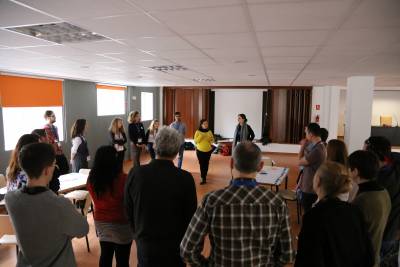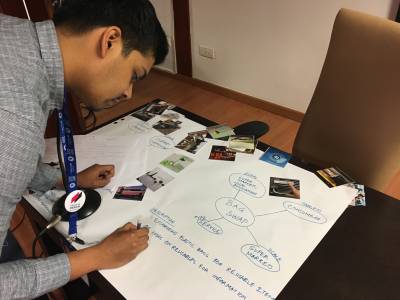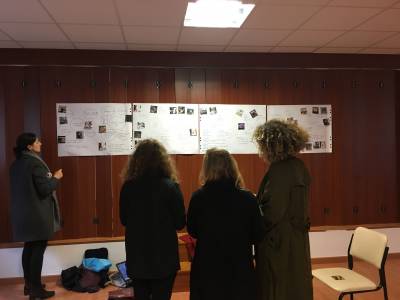Ceci est une ancienne révision du document !
Creative Jam in Lugo
Genesis and context of the project
In the context of the Atlantic Youth Creative Hub project, it was planned to set up a creative jam. The idea was to bring together students from several nationalities and hubs (10 in total) during a creative jam day. The animation was joint at Plymouth College of Art and The School of Design.
A previous day was dedicated to presenting the tools and specialties of each hub via workshops. To facilitate the creative jam and quickly go to prototyping and dedicate this creative jam to “doing”, we decided to devote our session dedicated to the presentation of the design thinking approach to an ideation to define already tracks of topics . Initially, representatives of each hub had to participate in the workshop and then build a prototype based on the ideation made the day before. Each hub should form a group of about 5 people. Organizational constraints had to change our approach, as all the hubs could not participate in the workshop the day before. The central question was therefore: How to go from an ideation to 8 people to a diffusion and development in rapid prototyping mode of these ideas on a group of 53 people?
Project Philosophy
The objective of this session was not so much to come up with innovative ideas as to create synergies and to have ambassadors to increase the mobilization of youth around the different hubs and the project. Thus, the workshop focused mainly on producing “prototypes” rather than on the feasibility or viability of projects. The idea of following Day 1 and Day 2 required choosing a theme to allow continuity. This theme was to be unifying hubs at the same time and apprehendable by all. If the theme chosen at Lugo was around creativity and employment, the choice of the theme focused on a peripheral element: plastic pollution in the oceans.
Description
Setting up a workshop bringing together 53 people - one-day prototyping students Particular difficulties: 1st ideation by a group of 8 people and passage to an ideation to 53 people. 5 different nationalities (4 languages) As part of the Atlantic Youth Creative Hub project, supported by INTERREG.
Animation
The School of Design & Plymouth College of Art * Supervision of groups: 4 master 1 students, 1 junior designer (Camille Chevroton, expert in design tools design), 2 staff of the School of Design (Educational Manager, Anaïs Jacquard, Research Manager, Hilda Zara), support of an expert on the subject: Pierre Yves Jaouen (Brest) * Framing and global framing: director sustainable city design lab & funding manager, plymouth college of art * Technical Framing (3D, ARDUINO): Fab Lab Plymouth College of Art
Note that all hubs have been used for expertise and support to groups
* Students: 8 teams (some hubs had no more students on the day): with diverse backgrounds ranging from master students in engineering, tourism, fashion … to young local mission reintegration.
Note: we decided not to mix hubs for reasons related to the progress of the project: the idea is to have through this creative jam to create synergies in the components of hubs (with already different horizons to inside each hub).
Preparation
Upstream, Hilda Zara, Florent Orsoni and Camille Chevroton have prepared tools to facilitate the animation of the workshop. A complementary session was realized with Hilda Zara, Camille Chevroton, Pierre Yves Jaouen, expert of the subject in Brest and the 4 students of the design lab present on this occasion, as well as Aneïs Jacquard, pedagogic director of the design lab come to the occasion conferences to present both the sustainable city design lab as well as the urban design approach of circular economy of the cities resources (see inspiring talks). This preparation made it possible to adapt tools already used in workshop tests (in Corsica in particular, also seminars in master 1), and also to propose specific tools (IDEA WALL and tool for generating ideas). 05_workshop_preparation1.jpg_400
Animation of the 1st day
Methodological tools
The program of the first day was devoted to the generation of ideas. 3 transnational groups have been formed. Each group could develop an idea but also produce another 3, with the aim that each participant should be ambassador of an idea.
* ICE BREAKING:
2 questions: what would you like to be by being plastic? What would not you like to be?

* Tool for generating ideas and collaborative enrichment A series of tools has been developed to generate ideas. The approach here was not based on a user journey but the life cycle of plastic (worked upstream with Pierre Yves Jaouen). The participants had to choose at what point of the cycle to intervene and see at that moment the possible interactions with the actors, the context, etc. The idea is to have a global vision of the entire life cycle and to see how to link the stages of this cycle, to generate new interactions.
https://youtu.be/RTEAPJEQr2A - doing brainstorming
This tool gave rise to multiple analyzes and project tracks, the actors finally focusing on education issues.
This step allowed a first generation of ideas. These ideas were then shared in plenary session to allow collaborative enrichment.
https://youtu.be/oYQNOBgCOLQ - sharing ideas
* Enriching ideas and inspiration
We brought the expert in the afternoon to provide context and depth (to avoid closing the game from the start). Then came an enrichment of ideas with a card game of inspiration. Collaborative enrichment allowed the joint selection of an idea.
https://youtu.be/utItHwdZIOI - Pierre's seminar
* Scenario development (see references to journey map)
The following steps were around generating usage scenarios to deepen ideas (development persona + journey map)
https://youtu.be/EsiFD4E48kI - pitch - end of day one
persona challenging your scenario scenario
* IDEA WALL: to ensure an articulation between a work of ideation and a work of rapid prototyping (while leaving possibilities of adaptation)
To ensure continuity between day 1 and day 2, design students completed an IDWALL. It was to structure the ideas generated during the exercise on a poster including: Name of the idea, Actors, description and photos inspirations / universe.


The idea is not to freeze the idea but to allow a reopening and reappropriation of them the next day. The images allow to open the field of: connection between elements a priori little related.
Description of ideas
The ideas were mainly related to education and advocacy issues. This approach was then confirmed the next day in project development.







